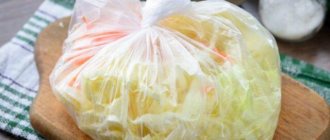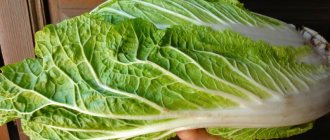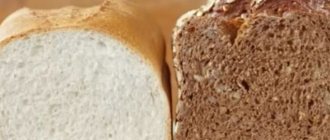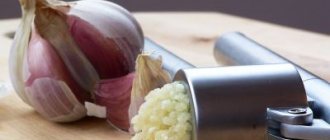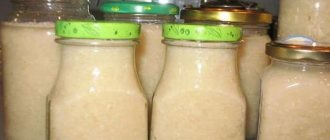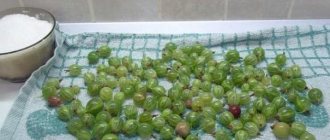Freezing vegetables for the winter will not only extend the season for consumption, but will also make it possible to always have them on hand. And this saves time and family budget. You can freeze almost all vegetables and berries that are sold frozen in the store.
At the height of ripening and harvesting they are cheaper than in winter. At this time of year, most are imported from abroad or grown in a greenhouse, which is reflected in the price.
Cauliflower is no exception to this rule. In winter it is sold fresh, but either greenhouse or imported.
How to properly freeze cauliflower
When freezing vegetables, you need to follow certain rules in order to preserve not only their beneficial properties, but also their appearance. Cauliflower is especially capricious in this regard; it can turn black or blue after freezing.
To prevent this from happening, you must adhere to certain rules. If you follow all the details of preparing a vegetable for freezing, the cabbage will retain its color, taste and smell. It will have a pleasant crispy texture when boiled, fried or stewed.
Cauliflower retains its beneficial properties perfectly when frozen. Freezing for the winter is easy and quick. Buying fresh in the summer season at the market or in the nearest supermarket is cheaper than buying frozen in winter.
Cauliflower, like other fruits and vegetables intended for freezing, must be fresh, without signs of spoilage. Small black spots can be cut off with a knife.
Before freezing, remove large leaves and disassemble the head into inflorescences.
Shorten the stalk of the inflorescences. Cut off small spots with a knife. Rinse thoroughly in cool water.
To be sure that you do not freeze the vegetable along with insects that also love cauliflower, soak in cold water with added salt at the rate of 1 tablespoon per 1 liter of water. Soak in salt water for about an hour. If insects settle in inflorescences, they will float to the surface.
Then drain the salt water and rinse the inflorescences with cold water.
Blanch the cauliflower in boiling water for 1-3 minutes. For one liter of water you need to add 10 grams of table salt (this is half a tablespoon) and one gram of citric acid.
Citric acid will keep the color of the inflorescences white, without an earthy tint.
To make the inflorescences acquire a snow-white appearance, it is better to add more citric acid: a level teaspoon of citric acid per two liters of water. This will not affect the taste of cabbage in any way. Blanching with the addition of only salt does not give such whiteness to the inflorescences.
Then remove the cabbage with a slotted spoon and cool quickly in cold water. This is necessary to remain crispy.
Drain and transfer to a sieve or bowl. Let the water drain. Place on a kitchen towel or paper towel. Let dry for 40-60 minutes.
After this, you can pack them in containers or plastic bags.
Before placing the bags in the freezer, the cabbage should be at room temperature.
Tie the bags tightly, releasing excess air, and place in the freezer.
The inflorescences can first be slightly frozen, laid out in one layer on a plate or tray, and then placed in a bag or box. This way they won’t stick together during freezing, and it will be easier to take the amount you need for cooking.
Other storage methods
It is not always possible to store large amounts of food in the freezer compartment. Therefore, many housewives are looking for ways to preserve food in other conditions.
Storage on the balcony
In winter frosts, a balcony can be an excellent alternative to a freezer. If this part of the apartment is not heated, then containers with fermentation can be placed there.
The rules are as follows:
- It is better to do freezing not with brine - so the liquid is drained;
- There is no need to squeeze the cabbage - moisture should remain in it;
- salted vegetables are placed in bags, plastic containers or glass jars;
- The containers are taken out onto the balcony and wrapped in blankets, blankets, etc.
Under such conditions, the product is stored and used as needed.
Cold storage
Keeping it in the refrigerator is possible for a short period of time - for 1-2 weeks, after which the workpiece will begin to sour and deteriorate.
In this case, it is better to store it in a glass container and use it regularly for food.
Usually the lower shelves of the refrigerator or the vegetable compartments are used - the temperature is lower there and the product will last longer.
Freezing cabbage
Another way to preserve this delicious dish is freezing. The recipe here is simple: the prepared mass is carefully squeezed out of the liquid by hand, put into bags and placed in the freezer for storage.
Sauerkraut has long been used as the main dish of Russian feasts. This is still relevant now, many centuries later, and is used not only for independent consumption, but also for filling pies, kulebyak, and pies. The method and process of storing sauerkraut is important for farmers and gardeners who have received a good harvest.
There are no similar posts
What's the best way to freeze cauliflower?
There is another way to freeze cauliflower. And not just cabbage. This method involves first drying the food.
At home, this can be done by placing the inflorescences on the rack of an electric dryer for vegetables and fruits. For those who don’t have such a dryer, dry them in the oven on a baking sheet.
With this method, the inflorescences do not need to be blanched before drying. When drying, some of the water is lost and the cabbage does not turn gray during freezing.
After preparing the inflorescences for freezing, place them on a drying tray.
Dry at a temperature of 45-55 degrees. In the oven at a temperature of 50-60 degrees, turning on the fan. If there is no fan, open the door slightly to allow air circulation.
Cool the dried inflorescences.
Then put into containers or bags.
After freezing, the inflorescences hardly stick together and are convenient to use for cooking. This method is called dehydrofrigation.
Choosing containers: what to look for?
Choosing the right container for freezing is no less important than preparing the vegetable itself for long-term storage.
Packaging requirements:
Ordinary plastic bags become brittle at low temperatures and can tear. Rectangular containers are more compact than round ones.
When choosing containers, you should consider how much vegetable you need to prepare one dish . Based on this, the required container volume is determined.
How to freeze cauliflower for feeding
Cauliflower is recommended for complementary feeding of infants from 5.5-6.5 months. When cabbage is grown in your own garden, you are sure that it does not contain harmful fertilizers or pesticides; it is worth freezing for the winter to feed your baby.
Preparation before freezing is similar. For baby food, it is recommended to take only the top inflorescences.
Before freezing, immerse in salted water for at least half an hour. Then rinse.
Blanch for 10 minutes. Then cool quickly in cold water.
Place the blanched inflorescences on a baking sheet or tray to dry.
Pack in containers, bags. Close or tie tightly. Label the package and put it in the freezer.
In addition to whole inflorescences, you can freeze the puree. Grind the boiled inflorescences in a blender. Place in small containers. Freeze in muffin tins. After freezing, transfer to a container with a lid or bags.
How long does cauliflower last in the freezer?
The shelf life depends on the temperature maintained by a particular freezer model. If properly prepared for freezing, it can be stored for up to 12 months.
It can be stored longer provided that the cabbage has not been thawed. It is still edible.
The table below shows the recommended shelf life
| Freezer temperature | Shelf life |
| minus 6 degrees | 2-4 weeks |
| minus 12 degrees | 3 months |
| minus 16 degrees | 9 months |
| minus 18-20 degrees | 12 months |
Preparing the refrigerator
To store large volumes of vegetables in the freezer, space is freed up. Fish and meat are not stored in the compartment with vegetable preparations. Household devices that maintain a temperature of −18 °C are suitable. The ideal option is if the refrigerator has a blast freezing function, its advantages:
- all beneficial substances are preserved in the vegetable;
- the appearance does not change;
- shelf life is extended.
In this mode, vegetable raw materials, spread out in a layer of 3-4 cm, freeze to the desired condition within an hour.
How to defrost correctly
It is recommended to defrost cauliflower before cooking or roasting. When defrosting, it is important not to lose beneficial qualities.
Slow defrosting at room temperature or in the refrigerator is recommended. However, the main question is how you are going to use it after defrosting.
If you want to make soup, you can immediately plunge the frozen product into boiling water and add the rest of the vegetables.
If you plan to use it for pies or cook it as an addition to lunch, it is worth defrosting and drying. It should also be defrosted before frying.
Defrosting in the microwave is not recommended, as this method loses most of the nutrients and the cabbage will be soft.
Re-freezing is not allowed.
Re-freezing
In order to rationally use frozen vegetables, it is recommended to immediately package them into portions . Otherwise, you will have to chop off the required amount of cabbage from a large piece or defrost all the excessively large amount of product at once.
If for some reason more cabbage was thawed than is necessary for preparing one dish, the question arises whether the preparation can be frozen again. You shouldn’t do this - you need to use everything in a day.
Once thawed, cabbage can no longer be re-frozen for the following reasons:
- loss of color, consistency, aroma and taste;
- loss of a significant part of nutrients;
- health hazard.
What to cook with frozen cauliflower
In terms of nutritional value, cauliflower is a valuable food product. Contains vitamins C, K, B6, B9. Minerals present such as:
- Sodium;
- Potassium;
- Magnesium;
- Calcium;
- Iron;
- Copper;
- Zinc;
- Phosphorus.
An important substance found in cauliflower is sulforaphane, which prevents certain types of cancer. Has many health benefits.
Eating cauliflower strengthens the kidneys and cardiovascular system. All thanks to the substance mentioned above. Contains fiber, which cleanses the body.
Due to its low calorie content, it is recommended in weight loss diets.
You can prepare the same dishes as with fresh cauliflower. Add to soup or cook with breadcrumbs and butter.
The floret sauce with mustard, coconut milk, sunflower oil, lemon juice, salt and pepper has an excellent taste and is suitable for salads or as a spread on a sandwich.
This vegetable goes well with meat, poultry, and fish. Can be fried in batter and served as a side dish or as a separate dish.
How long to cook frozen cauliflower
Remove frozen cauliflower immediately before cooking without defrosting.
Place in boiling salted water (2 teaspoons per 1 liter of water). It is also worth sweetening a little: 1 teaspoon per 1 liter of water.
Cook for 7-10 minutes. The countdown begins from the moment the water boils again.
Halfway through cooking, you can add milk to the water. After boiling, open the pan to allow the unpleasant smell to evaporate, then cook with the lid on.
To check readiness, insert a fork or knife. If it's soft, it's ready. Drain the water.
When serving, sprinkle with breadcrumbs and drizzle with melted butter.




